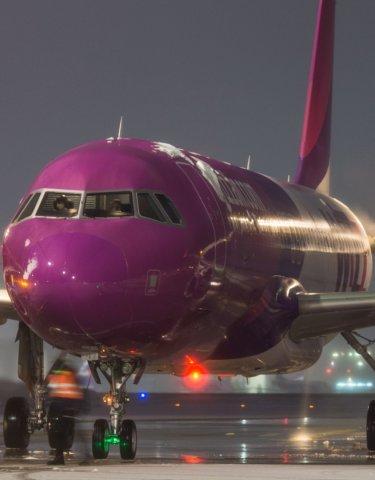This flight did not have to end dramatically, burying over seventy victims.The results of the initial investigation of the Russian Committee on Aircraft Accident Investigation clearly indicated the crew's mistakes, which disregarded the threats resulting from the risk of icing the aircraft.Metar weather message available for crews informed about snowfall and frost.Despite this, Captain Antonowa 148 refused to deduct the machine before departure.It also turned out that the crew did not launch deletion of speed sensors, and the so -called.pitot tube.And this despite the clear warning messages "Pitot: No Heating" (no heating), both during the taxi and during the erection.As a result, from a height of 1.300 meters Effect with ice sensors provided incorrect values.The crew did not know at what speed Antonov was moving, which ultimately caused a drag (Ang.stall) and sealed the fate of the airframe.
To cię zainteresuje Microsoft przygotowuje się na wsparcie składanych ekranówHyundai prezentuje chodzący samochód. Trzymam kciuki za ten konceptIce disregard is an unacceptable gambling in aviation.
De-icing on earth and in the air
The National Transport Safety Board, NTSB (NTSB) is an independent American government agency, whose task is to study aerial, road, water and rail accidents.NTSB has analyzed air incidents for nearly twenty years and it turned out that OK.Six hundred of them were associated with the "ice factor".In turn, NASA maintains that even 10% of fatal air accidents may result from the deadly operation.
Why is ice actually an enemy of the pilot?Of course, the drivers of passenger cars or trucks turned into a constant state of focus also does not make life easier, but it does not constitute a deadly threat.Oh, in our climate they are the most freezed windows or locks in the door.The plane, unlike the car, moves in three dimensions, for which it needs lift.This is produced by the wings, swimmed by the air in accordance with the correctness of aerodynamics, in the manner provided by the designers.If the aircraft is covered with a layer of ice or snow, the air can be disturbed.It ceases to be laminar as if the engineers described it.The permissible deviations are very small and even a thin layer of ice causes the loss of lift, especially in the critical start stage.
The disturbance of the air flow through the ice layer is not everything, because the ice increases the weight of the aircraft and its frontal resistance.And this causes the extension of the runway, sometimes so significant that the aircraft does not have enough lane to get into the air, which ends with a disaster at the threshold of the runway.Moreover, ice and snow set on aircraft can block the elements of the lobe mechanization (flaps, ailets, spoilers), which may result in the loss of machine control.Pieces of ice may break off the unputed or poorly cleaned plating.fan blades.With a possible consequence in the form of ignition and explosion of a power unit.
Czytaj dalej poniżejThe aircraft has its own depletion systems, but they are adapted for use during the flight.Their principle of operation varies.You can heat the edges of the wings and engines in hot air inlets from heat exchangers located in the drive units.Another system works in such a way that hot air is blown into rubber overlays on the edges of the attack, which "swells", which causes crushing on the edges of the wings of ice.Another method is, in turn, a spraying of de -icing fluid through mesh covers installed on the edges of the attack.A solution is also known to pouring the propeller pouring liquid, which is used in the most popular light aircraft.Electrical heating is also used to deduction of propeller of propellers, glass and air intakes.
De -Iicing FAQ - you ask
AntyWeb was invited at the beginning of January to Silesia to observe de-de-the aircraft directly on the airport in Katowice-Pyrzowice.A company dealing with terrestrial support for aircraft (so -called.Handling, as we wrote about in Antycyjba), LS Airport Services, made sure that tracking of decking was possible when it is the most visually spectacular, i.e. when the airport is still wrapped in the darkness of the night.In fact, it was an early morning, when from five o'clock the morning wave of departures from Katowice Airport began, thanks to which the next planes wrapped up on the decking plate every now and then.
Unforgettable experiences for aviation lovers.Supplemented with knowledge obtained from representatives of the Katowice and Warsaw branch of LS Airport Services, deepened in other sources.Let's present her in the form of questions that we asked on behalf of the readers Antycyj.
Dlaczego nie można odlodzić samolotu, zanim wsiądą do niego pasażerowie? Można by przecież uniknąć opóźnienia odlotu.

In short, it's about the so -called.Holdover Time, i.e. security time.The aircraft must be ready to fly in the shortest possible time and is therefore deducted with passengers and their luggage inside.What's more, the decking plate is located in front of the runway threshold.All this so that the aircraft was cleaned and protected against re -"glaciation" as soon as possible exposed to adverse weather conditions as possible.Protection of the aircraft works for a maximum of several to several dozen minutes, depending on the fluid used and external conditions used.If the plane does not start at this time, it must be cleaned and secured again.
Czy odladzanie zaczyna się, kiedy temperatura powietrza na lotnisku spada poniżej zera?
No, much earlier.Basically, in Katowice Airport, readiness to de -core begins on the first of September, i.e. ... in the summer.Efficiently, the first aircraft was subjected to De-Iicing on September 26 the previous year.A high humidity is enough, and at the ends of the wings and the tail you form frost or ice, even if the temperature is several degrees above zero.The factor conducive to the formation of ice is overloaded fuel, as at the cruising height there is a reaching temperature minus fifty degrees Celsius.Also in the summer you do not forget about deduction, because it is a period of training and equipment maintenance.
Czy tęgi mróz to najgorsze warunki pogodowe w przypadku odladzania?
Not always.Moderate frost and dry air cause de -deduction not necessary at all.Especially in the case of a short time.Turnover Time, i.e..after arrival and ok.a half -hour stay at the airport, the plane goes to the next cruise.A much worse option is a freezing rain or drizzle at the so -called.passing through zero, i.e..precipitation begins at a positive temperature, followed by frost.This leads to the rapid building of the glassy, thick ice, difficult to remove.And very treacherous, because he not only spoils the aerodynamics of the airframe, but significantly increases its weight and can lead to blocking the elements of mechanical control of the tail.
Kto decyduje o odladzaniu i kto je wykonuje?
The decision is made by the captain of the aircraft, taking into account the weather conditions in the airport.Particular attention is paid to the standard weather message, the so -called.Metar and of course for the external condition of the aircraft during the preceding celebration of each start.For example, it is also important.whether the plane came from a warm or cold area.It happens that the captains of aircraft operating from the so -called."Warm countries" give up decking, which took place during the stay of envoy Antytyb in the case of the Turkish onur Air cruise.The commander of the aircraft decides in consultation with the terrestrial service worker about de -icing.In the next step, an employee of a trading company selects the appropriate proportions of the removal fluid and water, depending on the outside temperature.At the Katowice De-Iicing airport, it takes place in parallel at two positions that are on the decking plate.The LS Airport Services company uses two Kiiitokori vehicles that simultaneously deduct the plane, thanks to which this process lasts no more than a dozen minutes.
Jako długo utrzymuje się na samolocie płyn zabezpieczający?
Briefly, because when the plane accelerates on the runway, the rush of air causes that jelly glycol and possibly ice or snow, which they settled on it, break away from the plane.The surface of the airframe becomes clean and smooth, ensuring the fulfillment of the aerodynamic parameters provided by the manufacturer.Thanks to this, the aircraft produces the load -bearing force necessary for start and erecting and maintains steering.
Czy odladzanie jest zautomatyzowane?
No, it is performed directly by an employee who is called "sprayer" in the airport nomenclature.His work is very responsible, because by deducting the plane, he cannot damage it.In particular, he must take care of the right direction of the nozzle and keeping the right distance to the elements of the aircraft surface, so that the mixture dose under the pressure does not cause, for example.dent.When de -icing, of course, not only the condition of the machine is important, but above all the safety of passengers.Therefore, the airframe must be properly configured.Air acceptance from the outside is closed so that the de -icing mixture does not get inside.If this happened, there could be smoke and even a fire.In any case, in this case, it would be necessary to cancel the cruise and refer the aircraft to the review.The de -icing employee, the "sprayer" mentioned, operates the nozzles from the closed cabin on the boom or from the open basket, depending on the type of deck.
Czy podczas odladzania silniki samolotu są włączone?
Basically - yes.Michał Sikora, Flight Coordinator at the Katowice airport: "In the standard configuration, the aircraft has engines during decking gave us exhaustive explanations..The engines must be turned off when the wing is deducted.If it is a turboprop aircraft, the rule is that the propellers must be stopped.E.g.On the ATR aircraft, we do not have the so -called auxiliary unit.APU.Engine No. 2 in this aircraft is still turned on but the propeller is stopped.There is a mechanism with a clutch and we call this configuration 'Hotel Mode'.So the engine works and the propeller stands still."
Czy samolot odladza dowolna firma handlingowa?
No - airlines have contracts signed with trading companies for comprehensive ground service, which is de -icing when it is required.There are two traders in Katowice, the aforementioned LS Airport Services and Welcome Airport Services, both will be the property of the Treasury.LS Airport Services, the largest ground service agent in Poland, signed a contract at the beginning.
Ile kosztuje odladzanie?
Quite a lot.But let's start with how much glycol is used.Simply put, glycol, because it is not a pure glycol, but a special fluid -based fluid (so -called. “type I" koloru pomarańczowego oraz “type II" - zagęszczony, koloru żółtego).It even comes out a few hundred liters on the plane, of course the greater, the greater the consumption of this fluid.Let's also remember about weather conditions - the colder, the more glycol and less water in the mixture.In total, on average, about 300 llitra glycol mixture in the case of a narrow-body Boeing 737-800 or Airbus A320 narrow-year-class class is falling on an average of.DE-ICING BOEING 767 wide-bodily means consumption of almost half a thousand liters.And pure glycol is ok.5 euros per liter.In practice, one decking of the aircraft costs over one and a half thousand euros.Representatives of LS Airport Services are obviously not willing to provide exact amounts because they are the secret of the company.It is well known, however, that this is one of the most expensive individual services in the price list of a trading company and brings it a lot of profits.
Glycol
Unfortunately, the use of glycol to de -de -de -the aircraft has disadvantages - once that it is expensive, two, that rather for a bakier with ecology.This is where numerous ideas for limiting or eliminating this fluid came from.Let's start with the more realistic ones.
At the New York JFK airport, there is an infrared decking installation, the largest of this type in the world, capable of accommodating the largest boeing 777 aeroplasts or even 747.Infrared radiators are able to replace the entire first degree of decking (cleaning the aircraft of ice, snow and frost), but the second degree, protection for the start is already carried out with the help of traditional glycol.Infrared technology is also available at other American airports, where glycol consumption dropped by up to 90%.A similar installation is available to the airport in the Norwegian Oslo, where glycol saving is estimated at 50-70%.
Another direction is an attempt to use hydrophobic coatings, i.e. repulsive water.This is the basis of the Phobic2ice (Super-Icephobic Surfaces to Prevent Ice Formation on Aircraft, superhydrophic surfaces to prevent ice to prevent the aircraft).An experimental solution has been developed forming a coating with nanoparticles, making aluminum pushing water and prevents ice.One of the scientists involved in the project explains this effect as follows: "Nanoparticles form spikes between which air is imprisoned. Powietrze zapobiega przedostawaniu się wody do środka, dzięki czemu woda po prostu spływa z powierzchni".The secret is supposedly in the surface of the lotus leaves, whose nanoscopic structure means that they are not able to easily get wet or dirty.
The Polish -sounding thread is also present in the struggle.A certain Dr. Konrad Rykaczewski from the Arizona State University began research on a special anti -conciliar coating.He took a frog from the woody family as the prototype.In her skin we will find two types of glands, one of which secretes mucus and the other is poison.This gave Rykaczewski the basis for constructing a hydrophobic coating.
And finally, the concept of a doctoral student from the University of Cambridge and the Silesian University of Technology, Dawid Janas.It intends to cover planes with a network of carbon nanotules with a diameter of ten micrometers and pass them with electricity.Such a layer would warm up almost immediately, melting ice, snow or frost on the plane.
Why deduct?I will warm up from another plane
In many aircraft disasters in which the aircraft was iced, man failed (the so -called.Human Factor).At the outset, we mentioned the incident from last year, in which the lack of compliance with anti -conciliation procedures by the crew of Russian Antonov 148 led to the tragedy.But carelessness has no nationality.
At the end of the eighties, an Air Ontario plane crash took place in Canada.The pilots did not agree to deduction, because it would lead to delay of the flight, for which the lines were harshly punished by the crews.
In the early eighties, Boeing 737 of the American Air Florida line collapsed into the offspring.By the way, he hid on the bridge, crushing several passenger cars and a truck.Over seventy on board joined the four fatal victims on the ground, only five survived. Doprowadził do tego czynnik ludzki w postaci wysoce niekonwencjonalnych działań kapitana Wheatona w zakresie “samodzielnego" odladzania. Chcąc przyspieszyć topnienie lodu, kołował swoim samolotem zaraz za poprzedzającą maszyną, aby … “ogrzać się" w strumieniu jej gazów wylotowych.The flowing water froze again, which resulted in the icing of speed sensors.The machine started at too low speed without the necessary load -bearing force, which led to drag on.The captain did not use the on -board decking systems because he found them ineffective.To make it not enough, he used the string to move along the runway.And this meant that the airframe was sucked in large amounts of ice and snow straight into the engine gondola.
We will also find here other testimonies of "creativity" in de -icing aircraft, not necessarily in the desired direction:
Lot and ice?You can see that the glycol shower for several thousand euros performed by a trading company will remain irreplaceable for a long time.Well, unless one of the fancy ways to protect the aircraft coating on the pattern of frog.
(Title photo - Michał Woźny) See all entries devoted to aviation.


